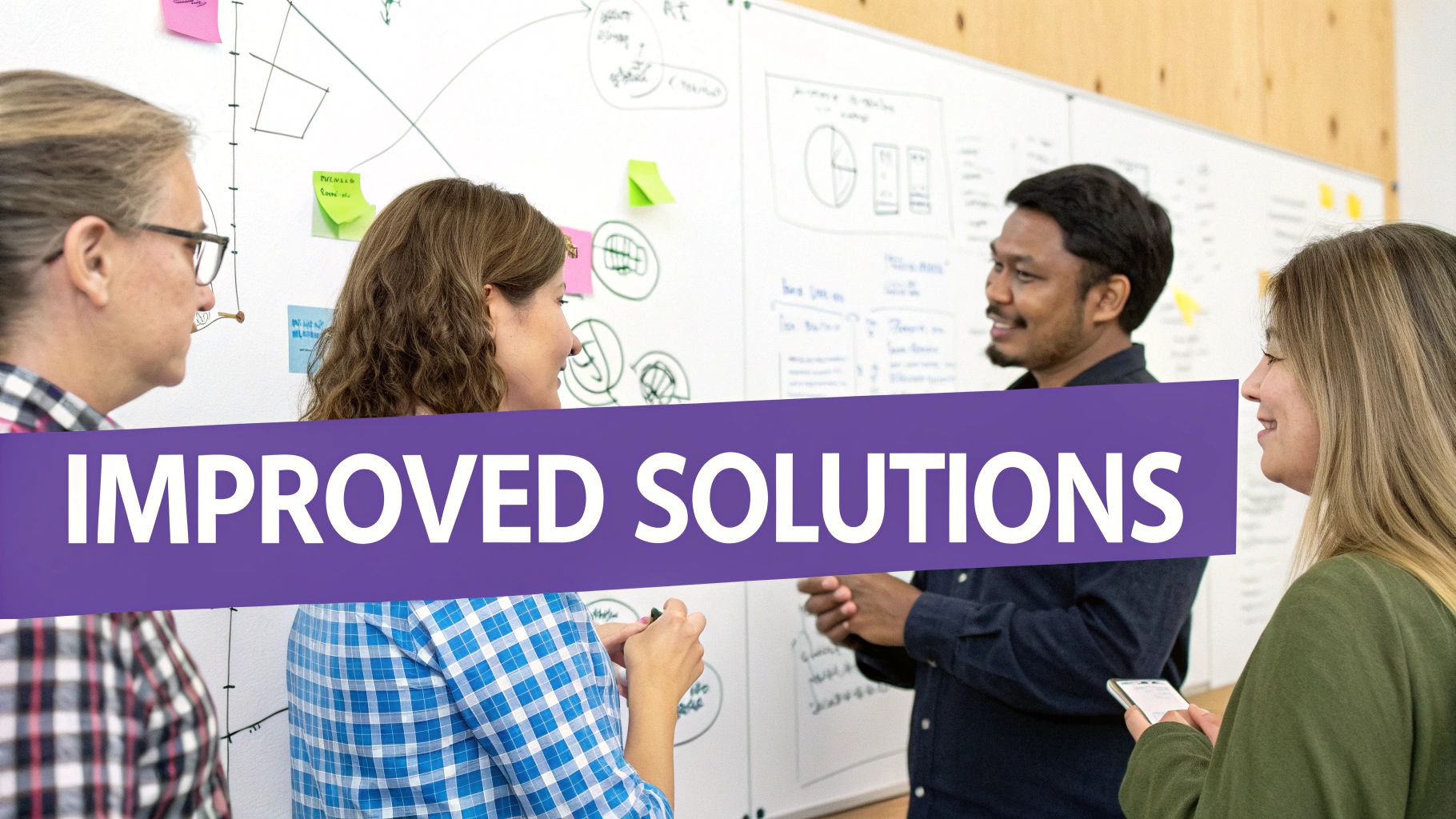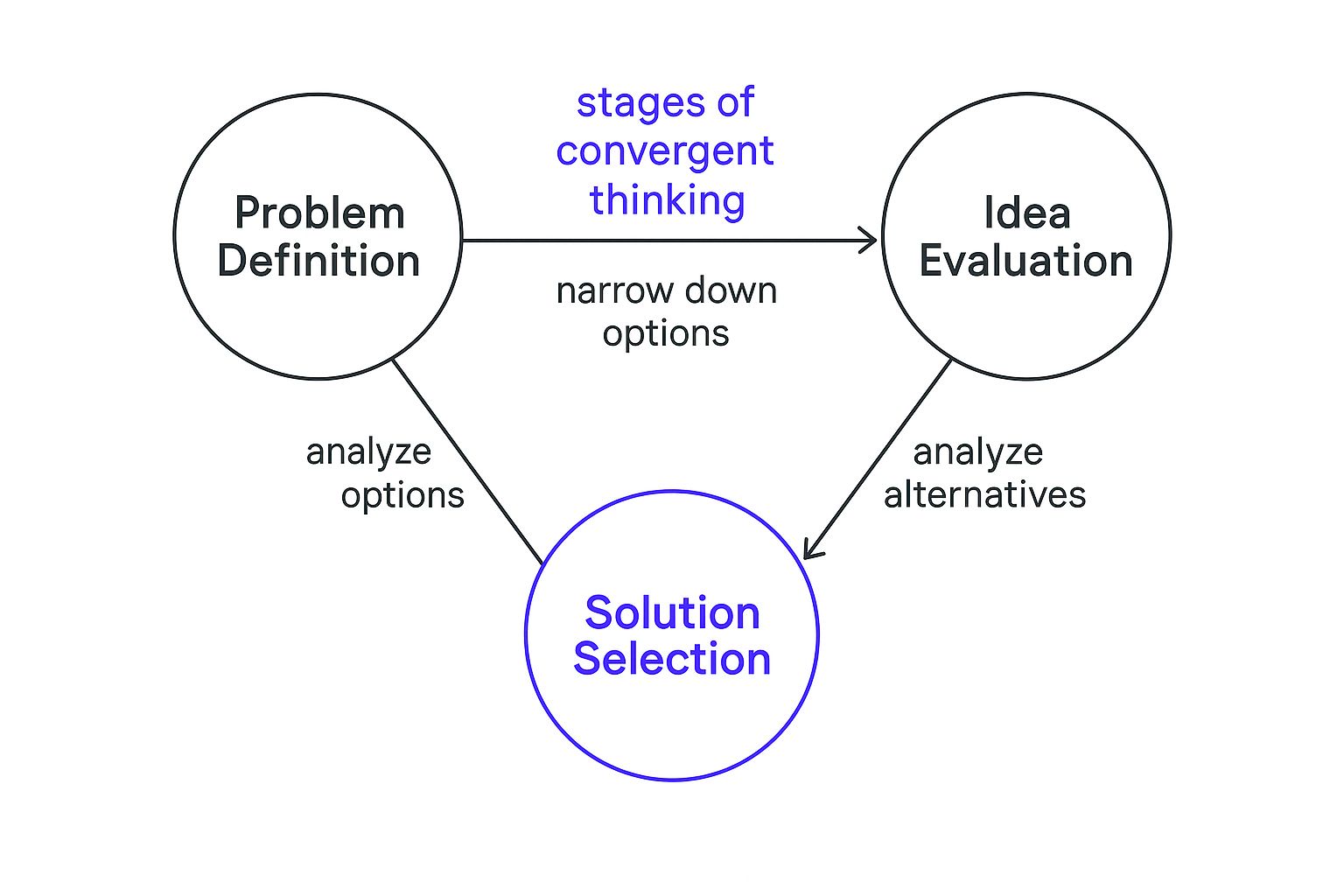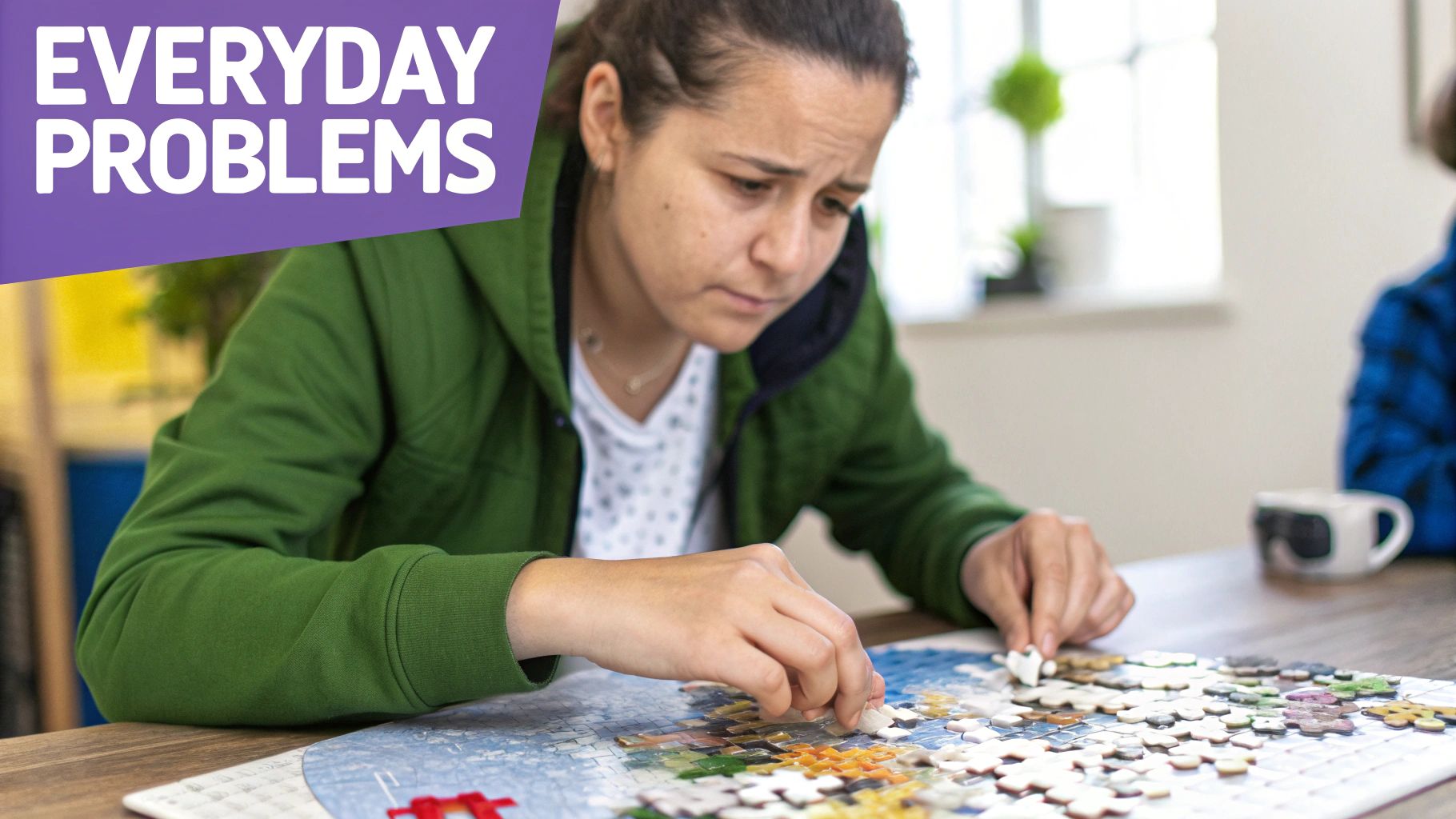At its core, convergent thinking is your brain's logical, step-by-step process for finding the single best answer to a problem. It's all about speed, accuracy, and applying what you already know, rather than trying to invent something new from scratch. Think of it as the mental tool you grab to answer a multiple-choice question or pick the fastest route on a map.
What Is Convergent Thinking, Really?

Convergent thinking is a focused and analytical way of thinking. It's the practice of systematically narrowing down a wide field of options to zero in on the one correct or best solution. Unlike its more free-spirited cousin, divergent thinking, this method thrives on logic, facts, and a clear structure.
Imagine a detective piecing together clues at a crime scene. They aren't just making up wild theories. Instead, they gather evidence, analyze the facts, and start eliminating possibilities one by one. That methodical process of elimination is the very heart of convergent thinking. The goal isn't to wander down every potential path, but to follow a direct route to a solid conclusion.
Key Characteristics of This Process
This type of thinking has a few distinct traits that make it so powerful for certain tasks, especially when a problem has a clear, verifiable answer.
- Logic-Driven: It follows a straightforward, step-by-step sequence based on reasoning and established rules.
- Accuracy-Focused: The main objective is to land on the correct answer with precision. There's no room for "close enough."
- Efficiency: It helps you make quick, effective decisions by filtering out all the noise and irrelevant information.
- Knowledge-Based: It relies on using the information you already have and applying proven procedures to solve a problem.
Convergent thinking is the intellectual engine that drives clarity. It cuts through the noise of too many options, allowing you to make decisive choices based on facts and evidence, not just a gut feeling.
This methodical approach is absolutely essential for anyone looking to sharpen their decision-making skills. By honing this skill, you can confidently handle situations that demand a single, effective solution. If you want to dive deeper into practical frameworks, our guide on a structured problem-solving approach is a great next step. It's the kind of thinking that's behind everything from diagnosing a tech bug to picking the right person for the job.
Where Did the Idea of Convergent Thinking Come From?

To really get a handle on convergent thinking, it helps to go back to where the idea started. This isn't some new-age business fad; it’s a concept deeply rooted in cognitive psychology, giving us a name for how we solve problems with logic and precision.
The term was officially coined by psychologist Joy Paul Guilford back in 1967. His work was a game-changer because it drew a clear line between the different ways our minds tackle creative challenges. Guilford identified convergent thinking as the process of zeroing in on a single, correct solution using a logical, step-by-step approach.
This was a big deal. It neatly separated the act of finding one right answer from the more chaotic process of generating lots of ideas, which he called divergent thinking. You can learn more about Guilford’s impact on cognitive psychology on Study.com.
Why Guilford’s Distinction Matters
Guilford’s work gave us a language to talk about two very different but equally vital mental gears. He showed that to solve problems well, you need to be good at both creating options and then skillfully whittling them down to the best one. This balance is crucial in just about everything we do.
Think about it. Sometimes you need to let your mind wander and explore, like an artist sketching dozens of rough ideas for a painting. Other times, you need to find the one correct path, like a pilot running through a precise pre-flight checklist. There's no room for maybe.
This separation of thinking styles highlights a core truth about how we think: we need a balance. We must be able to explore creatively but also analyze logically to make effective decisions.
From Theory to Everyday Application
Guilford's theory wasn't just for academics; it has had a huge influence on the real world. The core idea of convergent thinking is the foundation for most standardized tests, from IQ assessments to the SATs. These tests are designed to measure your ability to pick the single best answer from a list of options—a classic convergent thinking task.
This history shows why getting a grip on convergent thinking is so important. It’s the engine behind performance in high-stakes fields where one right decision can make all the difference, such as:
- Medicine: Doctors use it to diagnose an illness by methodically ruling out different conditions based on a patient's symptoms and lab results.
- Engineering: An engineer applies it to calculate the single most efficient and safe design for a bridge or building.
- Finance: An analyst relies on it to pinpoint the best investment after carefully evaluating data and eliminating riskier choices.
Convergent vs. Divergent Thinking Explained
To really get a handle on convergent thinking, it helps to put it right next to its creative twin, divergent thinking. They might sound like jargon from a psychology textbook, but they're just two different ways our brains tackle problems. Think of them as two essential tools in your mental toolbox, each with a very specific job.
Imagine a chef in a busy kitchen, carefully following a recipe to bake the perfect chocolate cake. They're using precise measurements and a clear sequence of steps because they're aiming for a single, delicious outcome. That’s convergent thinking in action. It’s logical, structured, and all about finding the one best answer.
Now, picture an artist staring at a blank canvas, brainstorming ideas for a new painting. They aren't searching for a single "right" concept. Instead, they’re sketching, splashing colors, and letting dozens of wild, unrelated possibilities fly. That’s divergent thinking—it's free-flowing, messy, and designed to generate a ton of different options.
This visual breaks down the step-by-step nature of convergent thinking, showing how it moves logically from a problem to a final, chosen solution.

As you can see, it acts like a funnel, systematically filtering and narrowing down all the possibilities until only the most practical, actionable one remains.
Core Differences in Goals and Process
The biggest difference between the two really comes down to their end goals.
Convergent thinking is all about getting to a single, correct answer. It works by applying logic, facts, and established knowledge to a problem. You’re using convergent thinking when you solve a math equation or troubleshoot a technical glitch on your computer. It’s a very linear, analytical process.
Divergent thinking, on the other hand, is about generating variety and novelty. The goal isn't to be "right" but to explore as many avenues as possible, no matter how unconventional. The process is spontaneous and non-linear, prioritizing imagination over rigid rules. This is your go-to mode for brainstorming new marketing taglines or dreaming up features for a new app.
To see how these two thinking styles team up, it's worth exploring the creative problem-solving process where they both play critical roles.
While divergent thinking casts a wide net to catch as many ideas as possible, convergent thinking carefully sorts through the catch to find the single most valuable fish. Both are essential for a successful catch.
To make this crystal clear, here’s a quick side-by-side comparison.
Convergent Thinking vs Divergent Thinking at a Glance
This table breaks down the key attributes of each thinking style to highlight their unique functions.
| Attribute | Convergent Thinking | Divergent Thinking |
|---|---|---|
| Goal | Find the single best solution | Generate many possible solutions |
| Process | Linear, logical, and systematic | Non-linear, spontaneous, and free-flowing |
| Focus | Speed, accuracy, and logic | Novelty, originality, and imagination |
| Questions Asked | "What is the correct answer?" | "What are all the possible answers?" |
| Best For | Standardized tests, problem-solving with known solutions | Brainstorming, creative projects, open-ended problems |
| Outcome | One correct or optimal solution | A wide range of diverse ideas |
Ultimately, these two ways of thinking aren't opponents; they're partners. Real, effective problem-solving needs both. You use divergent thinking to create the options and convergent thinking to make the final choice. By getting good at both, you become a powerful thinker—someone who can innovate creatively and then execute decisively.
Seeing Convergent Thinking in Your Daily Life
You might think "convergent thinking" sounds like something reserved for boardrooms or academic tests, but the truth is, you use it all the time without a second thought. It’s the logical, step-by-step thinking that kicks in whenever you have a problem with one right answer. It’s what helps you find clarity and make things happen, both at home and at work.
Ever seen a mechanic trying to diagnose that weird knocking sound in an engine? They don't just start yanking out parts at random. They follow a methodical process of elimination: listen to the sound, check the oil, test the spark plugs, inspect the belts. They rule out possibilities one by one until they find the culprit. That’s convergent thinking in its purest form.
At its heart, convergent thinking is all about moving from a wide array of possibilities to a single, correct answer. You do this by applying logic and what you already know. It’s not about inventing a new path—it’s about finding the right one.
This same focused approach drives countless everyday tasks. It’s what you do when you solve a Sudoku puzzle by eliminating numbers, troubleshoot your spotty Wi-Fi by checking the router and cables, or follow a recipe to the letter to bake a perfect cake.
Professional Scenarios and Practical Outcomes
In the professional world, this skill is absolutely critical for making sound decisions. It’s what separates a solid, evidence-based choice from a wild guess. Think about a project manager who needs to pick the best software for their team. They’ll gather data on features, pricing, and support, then systematically compare each option against a strict list of requirements to find the one that truly fits.
Here are a few more real-world examples of this in action:
- A Doctor’s Diagnosis: A doctor listens to a patient’s symptoms and reviews their medical history and lab results. They use this information to methodically rule out different illnesses until they can confidently identify a specific diagnosis.
- A Financial Analyst's Choice: An analyst sifts through dozens of stocks, applying financial models and risk assessments to filter out the duds and pinpoint the single best investment for a client.
- A Recruiter’s Selection: A hiring manager reviews hundreds of resumes, screening each one against the precise qualifications needed for the job to narrow the field down to the very best applicant.
In all these cases, the objective is the same: start with a broad field of options and logically narrow it down to a single, defensible conclusion.
Refining Ideas and Making Decisions
This structured way of thinking is also essential after a creative brainstorming session. Divergent thinking is great for generating a flood of new, exciting ideas, but it’s convergent thinking that helps you sort through the noise and turn those possibilities into a solid plan. It's the moment your team shifts from asking "what if?" to deciding "what's next?"
In many practical applications, like in group mastermind settings, this is the process that helps turn abstract concepts into concrete, actionable steps.
Ultimately, you need both types of thinking to be a truly effective problem-solver. Knowing https://www.remotesparks.com/how-to-run-a-brainstorm-session/ helps you generate fantastic ideas, and applying convergent thinking ensures you pick the winner. By recognizing and sharpening this skill, you’ll bring more precision and confidence to every decision you make.
Why Mastering Convergent Thinking Matters

So, why should you care about getting better at convergent thinking? It’s not just some abstract concept from a psychology textbook; it’s a practical skill that pays off daily, both at work and in life. It's what allows you to slice through the noise, make sharp, accurate decisions, and do it all with less stress.
When you really hone your convergent thinking, you become much more effective in any situation that demands structure and logic. Think about taking a multiple-choice exam or digging into a data-heavy project. This is the skill that helps you find the right path, fast.
Driving Clarity and Reducing Risk
People who are strong convergent thinkers often make the most decisive leaders. In fields like engineering, finance, and medicine, there’s no room for waffling. The ability to analyze information, weigh the evidence, and commit to the single best solution is essential. They don't get lost in "analysis paralysis."
Instead, they move forward with confidence, which is critical for reducing risk when the stakes are high. Convergent thinking acts like a filter, stripping away ambiguity and emotion to reveal the most logical course of action. It's not about killing creativity—it’s about applying it to a specific, tangible goal.
Convergent thinking is the anchor that keeps decision-making grounded in reality. It transforms a sea of possibilities into a single, reliable course of action, providing the clarity needed to drive progress and achieve goals.
This skill is also your best defense against the mental traps that can lead to bad choices. To take it a step further, it helps to understand the common slip-ups our brains are prone to making. You can explore this more by learning how to spot and overcome cognitive bias in decision-making.
A Cornerstone of Critical Professions
The real-world importance of convergent thinking is well-supported. Research shows that approximately 70%-80% of critical decisions—the ones that truly matter—rely heavily on this skill. It's all about synthesizing information to find that one best answer.
For a powerful example, picture a surgeon in a high-pressure trauma situation. They must use convergent thinking to decide in a split second whether to stop massive bleeding or address a collapsed lung first. There’s a single best answer, and finding it is a matter of life and death.
This cognitive process is so fundamental that tests measuring intellectual ability often use convergent tasks. On these assessments, participants' accuracy in selecting the single best option typically falls between 75% and 90%, highlighting how vital this skill is in professions where logic and efficiency are everything. You can read more about the research behind convergent thinking's role in cognitive psychology on Fiveable.
Ultimately, mastering this way of thinking is about more than just finding the right answer on a test. It’s about building the confidence and clarity to solve complex problems, lead with conviction, and navigate a world that constantly demands clear, logical solutions.
Frequently Asked Questions About Convergent Thinking
As you start to wrap your head around convergent thinking, a few questions almost always come up. Let's tackle them head-on to clear up any confusion and show you how this skill really works in the real world.
Think of this as the final piece of the puzzle, connecting the dots so you have a solid, practical understanding of convergent thinking.
Can Someone Be Good at Both Convergent and Divergent Thinking?
Absolutely. In fact, the most effective problem-solvers are great at both. It's best to think of them not as fixed personality types, but as different mental "gears" you can learn to shift between.
While you might naturally prefer one style over the other, anyone can practice and get better at both. The real goal isn't to be one or the other; it’s about having the mental flexibility to open up with divergent thinking and then focus in with convergent thinking to make a final choice. This dynamic duo is the secret sauce for great problem-solving.
Is Convergent Thinking the Same as Critical Thinking?
They're very close cousins, but not identical twins. Convergent thinking is a specific mental process—it’s all about using logic and known facts to find a single, best answer. It's a vital part of critical thinking.
Critical thinking, on the other hand, is the bigger picture. It’s a whole toolkit of skills for analyzing information, spotting biases, weighing evidence, and then making a sound judgment. It definitely uses convergent thinking to zero in on options, but it also includes skills like interpretation, reflection, and self-regulation.
Convergent thinking is the tool you use to find the right answer. Critical thinking is the entire workshop where you inspect that answer and question how you got there in the first place.
How Can I Improve My Convergent Thinking Skills?
Getting better at convergent thinking is all about practice and embracing a more structured way of looking at problems. It’s a muscle you build, not something you’re just born with.
Here are a few straightforward ways to sharpen your skills:
- Solve Logic Puzzles: Things like Sudoku, crosswords, and logic grid puzzles are fantastic training. They force you to use deduction and eliminate possibilities until you arrive at the one correct solution.
- Use Structured Frameworks: Get comfortable with decision-making tools. A simple pros and cons list is a great start. A decision matrix or a SWOT analysis (Strengths, Weaknesses, Opportunities, Threats) can help you evaluate your options in a much more organized way.
- Practice Root Cause Analysis: When something goes wrong, don't just patch the issue. Keep asking "why?" to dig down to the real source of the problem. This forces a logical, step-by-step investigation that is pure convergent thinking.
How Does Convergent Thinking Apply to Teamwork?
In any team, convergent thinking is what turns a freewheeling brainstorm into a concrete action plan. After a wild session of divergent thinking where tons of ideas are thrown on the table, the team needs to shift gears. It's time to evaluate, refine, and pick the idea that actually makes sense to pursue.
This is the moment when the team needs to:
- Set Clear Criteria: First, everyone agrees on what makes an idea "good." Is it the budget? The timeline? The resources we have?
- Analyze the Options: Each idea is then measured against those agreed-upon rules. No more "I just like this one."
- Build Consensus: Finally, the group works together to land on a single decision that everyone can get behind.
Without this structured phase, creative sessions can easily turn into endless talk with no results. Getting this right is especially crucial for fostering innovation in remote teams, where focus and clarity are key to moving forward together.
Ready to transform your team's brainstorming sessions from chaotic to clear? Bulby provides a guided, step-by-step process that helps your team generate brilliant ideas and then use focused thinking to turn them into actionable plans. Say goodbye to messy idea generation and discover a smarter way to innovate at https://www.bulby.com.

